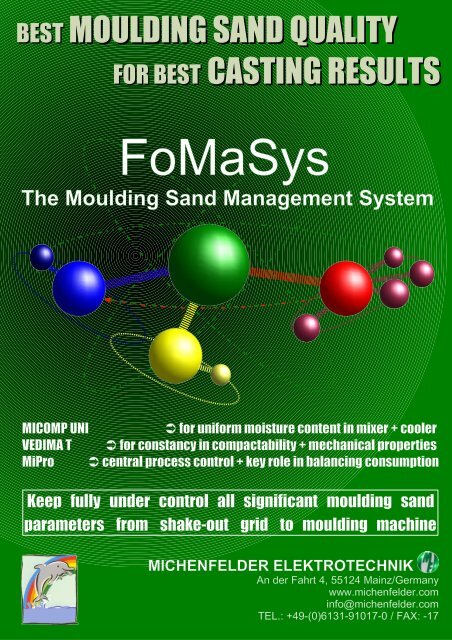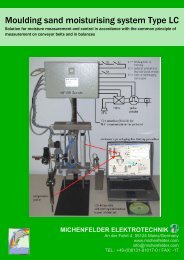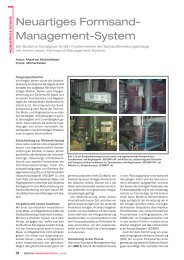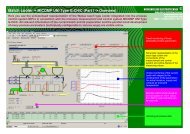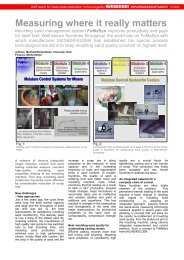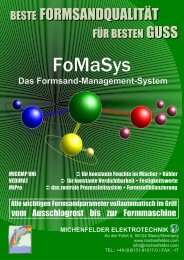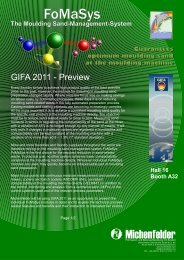michenfelder elektrotechnik
michenfelder elektrotechnik
michenfelder elektrotechnik
You also want an ePaper? Increase the reach of your titles
YUMPU automatically turns print PDFs into web optimized ePapers that Google loves.
BEST<br />
MOULDING SAND QUALITY<br />
FOR BEST CASTING RESULTS<br />
FoMaSys<br />
The Moulding Sand Management System<br />
MICOMP UNI � for uniform moisture content in mixer + cooler<br />
VEDIMA T � for constancy in compactability + mechanical properties<br />
MiPro � central process control + key role in balancing consumption<br />
Keep fully under control all significant moulding sand<br />
parameters from shake-out grid to moulding machine<br />
MICHENFELDER ELEKTROTECHNIK<br />
An der Fahrt 4, 55124 Mainz/Germany<br />
www.<strong>michenfelder</strong>.com<br />
info@<strong>michenfelder</strong>.com<br />
TEL.: +49-(0)6131-91017-0 / FAX: -17
New challenges – New approaches<br />
Just a few years ago, the cycle times were long, the sand bunker capacity was large and the<br />
throughput of sand per shift was low i.e. the best requirements for satisfactory moulding sand<br />
conditioning. This leisurely pace is now a thing of the distant past. By investing millions, the<br />
manufacture of high quality cast products has been switched to fast moulding lines, and moulding<br />
sand production has been switched to high performance mixers, mostly fitted with coolers. But just as<br />
sand capacity, cycle times and regeneration times in sand bunkers were reduced, the quality of sand<br />
dropped and scrappage increased. In modern foundries, the quality of sand is suffering as a result of<br />
ever faster mixer and moulding machine cycle times, frequent model changes, serious fluctuations in<br />
sand-metal-ratios and an ineffective and inconstant addition and extraction of additives and<br />
superfines. This has resulted in changes in the composition and homogeneity of the sand, with major<br />
repercussions for the mechanical properties of the sand such as compactability, compression<br />
strength etc.<br />
Best moulding sand quality for best casting results<br />
Efficient casting involves more than fast mixing and moulding. Consistently high quality moulding<br />
sand properties are a crucial factor for satisfactory casting and a low volume of scrappage. This<br />
conclusion has finally been accepted and needs to be addressed.<br />
A new approach<br />
Many foundries are often unaware of the problem. This permanent thermal loading of the sand<br />
requires a basic change in strategy with regard to moulding sand conditioning – i.e. adopting an<br />
integrated approach. Leaving behind the stand-alone measuring technology solutions applied in<br />
recent years and adopting a concept that will allow for the careful re-instatement of moulding sand<br />
quality, from the shake-out grid to the moulding machine, using cleverly integrated measurement and<br />
control systems.<br />
The idea behind FoMaSys<br />
Fast amortisation guaranteed<br />
Depending on the technical priorities and the available budget, the various FoMaSys modules can be<br />
installed in graduated steps for years to come. The design consists of a fully automatic moisture<br />
measurement and control system for mixers, coolers, conveyor belts, drums linked to online sandtesting<br />
systems that are placed directly in front of the moulding line (and deliberately not at the<br />
mixer). Ultimately, MiPro makes the sand cycle transparent, connections and correlation become<br />
clearer and you have full online control over all the important sand parameters. Never before has an<br />
investment in a moulding sand conditioning process paid for itself so quickly. It has been proven by<br />
successful international FoMaSys projects.<br />
FoMaSys<br />
The Moulding Sand Management System<br />
The idea behind FoMaSys is to create a network of intelligent measurement, control and testing<br />
systems, while at the same time trying to combat the effects of dehomogenisation and change by the<br />
application of process technology. Looking at additives and superfines, that means: Times and<br />
quantities of extraction and addition processes should be as equal and consistent as possible.<br />
Measurement and control technology ensures that first of all, the sand is reliably pre-wetted (with at<br />
least 2.0% H 2O) before it reaches the used sand bunker, and secondly, that it then reaches the<br />
moulding line with consistently optimum mechanical properties (flowable). This is achieved by using<br />
the tried and tested Michenfelder moisture measurement and sand testing systems which are<br />
networked and monitored centrally. The high level of automation produces rationalisation effects.<br />
Precision and reliability reduce scrappage, and continuous quality control ensures a sand<br />
conditioning process that is cost-effective and that consistently conserves resources.<br />
Michenfelder Elektrotechnik GmbH & Co. KG<br />
info@<strong>michenfelder</strong>.com | www.<strong>michenfelder</strong>.com<br />
MOULDING SAND MANAGEMENT SYSTEM
Moulding sand moisturising system Type LC<br />
Solution for moisture measurement and control in accordance with the common principle of<br />
measurement on conveyor belts and in balances<br />
MICHENFELDER ELEKTROTECHNIK<br />
An der Fahrt 4, 55124 Mainz/Germany<br />
www.<strong>michenfelder</strong>.com<br />
info@<strong>michenfelder</strong>.com<br />
TEL.: +49-(0)6131-91017-0 / FAX: -17
We can facilitate a price comparison<br />
To allow you to make a fair comparison, we have decided to expand our product range to include<br />
the low-cost moulding sand moisturising system LC. It is the alternative to competitors’ systems<br />
available in the market. The moisture probe is installed on the belt upstream of or in the used sand<br />
weighing device. This facilitates a true price comparison.<br />
Scope of delivery<br />
The LC system consists of a self-cleaning NF-SR moisture probe. The measurement generator and<br />
the processing unit are located in the separate steel-plate housing. The moisture values measured<br />
in Volt and the evaluated material temperature in oC are transmitted to the processing unit for<br />
conversion to a percentage moisture value. Forty years of experience at Michenfelder have gone<br />
into this data conversion process. The system has been designed for installation and<br />
commissioning by the customer. To facilitate this, we supply a CD ROM with commissioning report,<br />
program flow visualisation and instructions for the adjustment of the characteristic curve using the<br />
customer’s PC or laptop.<br />
Operating principle<br />
When commissioning is complete (when the calibration value curve has been drawn up), the NF-<br />
SR probe measures the initial material moisture. The integrated processing unit then calculates the<br />
volume of residual water to be added depending on the batch size. At the same time as the used<br />
sand flows into the mixer (filling process), the calculated water volume is automatically metered out<br />
to the required final moisture level that was preset.<br />
The principle of measuring moisture upstream of the mixer<br />
With regard to hardware technology and the measuring point upstream of the mixer, the LC system<br />
provides you with the same kind of solution as that offered by the competitors. If you are about to<br />
make this investment decision, you must remember that when measuring material on the belt or in<br />
the used sand bunker, in principle, only part of the volume of material in a full mixer batch can be<br />
recorded. This means that the accuracy of the initial moisture with reference to the entire batch is<br />
only an average max. of ± 0.2% H2O (in the 1st standard deviation). Depending on the clay<br />
content, this can result in variations of up to ± 5-10% in compactability at the moulding machine<br />
directly. This is common to all systems that measure moisture upstream of the mixer.<br />
Who is the LC system designed for?<br />
There are customers who, for financial or other reasons, cannot or do not wish to exploit the full<br />
potential for reducing the moulding sand related scrappage in their production system by improving<br />
moulding sand quality. In cases such as this, customers are chiefly concerned with improving sand<br />
preparation processes in the areas of mixing, moulding and casting generally. Therefore, if the<br />
primary motivation is to avoid “extreme outliers” in the area of moulding sand moisture that can<br />
frequently result in production stoppages, then the installation of the low-cost moulding sand<br />
moisturising system is a suitable alternative.<br />
Given the growing requirements in modern foundries, investments must be quickly<br />
amortised, i.e. they must pay for themselves. This is best achieved by fully exploiting all the<br />
optimisation potential provided by measurement and control technology in order to reduce<br />
scrappage in a sand preparation plant. For this, we recommend Michenfelder’s modular<br />
Moulding Sand Management System FoMaSys.
Future-proof<br />
and<br />
cost-effective<br />
from the<br />
start<br />
MICOMP UNI<br />
The fully automatic moisture control system<br />
type G-CH<br />
for batch mixers<br />
FoMaSys-Modul<br />
FoMaSys-Module<br />
No other decision to invest in measurement and control can have more<br />
far-reaching consequences in the field of modern moulding sand<br />
conditioning. It is a trend-setting system. If decisions are reached on the<br />
basis of technical priorities, precision, future development and<br />
expansion capabilities, and amortisation periods, the MICOMP UNI type<br />
G-CH is a must - regardless of whether an existing mixer is being<br />
modernised or a new green-field foundry is being established.<br />
Mastery of this technology is what has made a difference – for more<br />
than 30 years. Only through measurement in the mixer is the<br />
incomparably high reproducibility of the output moisture within very<br />
strict limits guaranteed. Since all the moulding sand components<br />
such as sand, bentonite, C-carriers and water only come together in<br />
the mixer, it is only there that a representative and precise<br />
determination of moisture can be made. This is the only way to<br />
achieve precise values of ±0.05 – 0.1% H 2O in the 1 st standard<br />
deviation over shifts, days and weeks.<br />
The patented<br />
mixing dynamic<br />
monitoring<br />
system<br />
Continuous<br />
measurement<br />
of moisture in<br />
the mixer<br />
This is used to get the maximum out of your mixer – without losing<br />
valuable time. The sand moisture in the mixer is constantly<br />
monitored, from the time material is charged until the moment of<br />
discharging. The total homogenisation and conditioning degree for<br />
each individual batch is displayed graphically in real time. This allows<br />
the operator to draw conclusions regarding the mixing dynamic, i.e.<br />
the performance capabilities of the mixer. The advantage: It is<br />
possible to prevent scrappage as a result of a drop in mixer<br />
performance and to optimise process steps such as the addition of<br />
water and material.<br />
Michenfelder Elektrotechnik GmbH & Co. KG<br />
info@<strong>michenfelder</strong>.com | www.<strong>michenfelder</strong>.com<br />
AUTOMATIC MOISTURE CONTROL SYSTEM FOR MIXERS
An<br />
investment<br />
that quickly<br />
pays for<br />
itself!<br />
Why does it<br />
actually<br />
need to be so<br />
precise?<br />
MICOMP UNI<br />
The fully automatic moisture control system<br />
type G-CH<br />
for batch mixers<br />
Is there any more convincing argument? Place your trust in the<br />
technology of the market leader and you will find out. You prefer to<br />
base your investment decision on facts – no problem either:<br />
� Hundreds of success stories regarding its use in all kinds of<br />
moulding sand mixers throughout the world<br />
� Maximum precision and reliable at every phase of production<br />
� Versatile software and hardware expansion options<br />
� Achievable precision of ±0.05 -0.1% H 2O*<br />
*(in the 1 st standard deviation)<br />
� As a basic FoMaSys module, it is designed for expansion<br />
and networking with the VEDIMAT online sand testing<br />
system (for constant compactability) and the central<br />
process control system MiPro<br />
FoMaSys-Module<br />
As a criterion for good casting quality, there is a greater emphasis<br />
than ever on constant mechanical sand parameters (e.g.<br />
compactability). The same applies to moisture content as a<br />
corrective element. But did you know that fluctuations of just one<br />
tenth at the mixer outlet can have a direct influence on<br />
compactability of up to 2-3% on the moulding line? No? Well<br />
now you know why the precision of moisture measurement and<br />
control systems needs to be measured in hundredths.<br />
Michenfelder Elektrotechnik GmbH & Co. KG<br />
info@<strong>michenfelder</strong>.com | www.<strong>michenfelder</strong>.com<br />
AUTOMATIC MOISTURE CONTROL SYSTEM FOR MIXERS
Where does the<br />
compactability of your<br />
sand need to be<br />
constant?<br />
The success factors – Part 1<br />
VEDIMAT<br />
The fully automatic online sand-testing system<br />
Do you measure the compactability values in the<br />
laboratory or at the mixer only? If that is the case, then<br />
you are wasting an opportunity to improve your casting<br />
quality and reduce scrappage. The VEDIMAT controls<br />
and regulates compactability and measures the<br />
compression strength directly in front of the moulding<br />
machine because this is the point at which the quality<br />
of your moulding sand should be at its peak.<br />
� The ideal place for installation<br />
Keeping compactability constant at the mixer is not very helpful. This does not<br />
identify or take cognisance of negative factors that affect the sand when it is<br />
being transported to the moulding machine. A combination of the VEDIMAT and<br />
the MICOMP UNI type G-CH systems reliably registers and compensates for<br />
these changes (e.g. fluctuations in temperature, evaporation and bentonite<br />
saturation effects) so that constant, high quality mechanical sand properties are<br />
achieved at the point where they are really needed – on the moulding line.<br />
� Networking a high-precision moisture measurement and control system<br />
As a compactability correction factor, sand moisture is a very important issue.<br />
Moisture fluctuations of one tenth at the mixer outlet can have a direct influence<br />
on compactability amounting to ±2-3% on the moulding line. So if you want to<br />
keep compactability constant within a narrow band, you need a moisture<br />
measurement and control system that measures and controls precisely within a<br />
few hundredths.<br />
FoMaSys-Module<br />
FoMaSys-Modul<br />
Michenfelder Elektrotechnik GmbH & Co. KG<br />
info@<strong>michenfelder</strong>.com | www.<strong>michenfelder</strong>.com<br />
ONLINE SAND-TESTING SYSTEM
The success factors – Part 2<br />
VEDIMAT<br />
The fully automatic online sand-testing system<br />
However, compactability is not affected by moisture<br />
alone. The sand composition and the bentonite<br />
saturation level are also crucial factors.<br />
Reducing costs by minimising scrappage<br />
The conceptual approach and technological implementation are crucial factors in relation to a<br />
successful outcome and whether the investment will be worth your while. Take a bet on the<br />
perfect combination of the two independent FoMaSys components, the VEDIMAT and the<br />
MICOMP UNI type G-CH.<br />
FoMaSys-Module<br />
FoMaSys-Modul<br />
� Identifying changes and taking gentle counter-action – before run into trouble<br />
The sand composition (i.e. the ratio of new, used and core sand, C-carriers, bentonite and<br />
other superfines) is permanently changing. In principle, the constant adjustment of the water<br />
requirement to the changing sand composition during the production process ensures that<br />
compactability automatically remains constant. By taking simple attendant measures, you<br />
yourself can further improve the level of precision. Ensure a constant composition and<br />
homogeneous distribution of the sand components by avoiding sudden, irregular additions<br />
during the sand cycle. Do your sand an enormous favour and act as follows with effort: Times<br />
and quantities of extraction and addition processes should be as equal and consistent as<br />
possible.<br />
� Avoid stress<br />
Short cycle times, high throughput and extreme, constant thermal loading place enormous<br />
stress on your moulding sand. There is barely enough time left for regeneration in bunkers, or<br />
there is not enough moisture in the bunkers to disperse the bentonite (at least 1.8-2.0%). If the<br />
sand fed to the mixer is too dry, full bentonite saturation is often not achieved before it leaves<br />
again the mixer. This results in major compactability fluctuations. And what can you do about<br />
it? Commence regeneration and conditioning early! Ideally in the cooler.<br />
Michenfelder Elektrotechnik GmbH & Co. KG<br />
info@<strong>michenfelder</strong>.com | www.<strong>michenfelder</strong>.com<br />
ONLINE SAND-TESTING SYSTEM
Sand conditioning reliability starts<br />
in the cooler<br />
1.8-2.0% H2O<br />
T h e c r i t i c a l f a c t o r<br />
Breath life<br />
into your<br />
moulding<br />
sand<br />
MICOMP UNI<br />
The fully automatic moisture control system for<br />
type G-MC/G-91/G-FBK<br />
mixer coolers and fluidised bed coolers<br />
Even at the cooler and used sand bunker, the die for high casting quality and<br />
minimum scrappage at the moulding line has been cast. Fast mixers, a high<br />
throughput, short cycle and bunker storage times are a real challenge when it<br />
comes to manufacturing high quality moulding sand. However, tough general<br />
conditions and a soft, flowable, well-conditioned moulding sand are not<br />
mutually exclusive – providing the right processing technology and<br />
measurement and control systems are used.<br />
If the used sand moisture at the cooler outlet is below the critical level of 1.8-2.0% H 20,<br />
regeneration cannot take place in the used sand bunker. The active bentonite content<br />
does not disperse. The sand remains static and lifeless. Valuable regeneration time is lost<br />
and cannot be clawed back at a later stage in the mixer. There is then just barely enough<br />
mixing time to homogenise the aggregates, but hardly for satisfactory conditioning. The<br />
result: When it gets to the moulding line, dispersion processes have not been<br />
completed, the sand is not flowable, the mechanical sand properties are not constant and<br />
your scrappage levels are correspondingly high.<br />
Kill at least two birds with one stone<br />
Not only do you lay the foundation for flowable moulding sand, satisfactory casting and low scrappage levels<br />
when your used sand moisture levels are sufficiently high. There is also another highly beneficial by-product<br />
when it comes to your conditioning process. You provide support for your sand mixer and the loading is<br />
massively reduced. Unlike in the case of dry sand, the sand mixer can intermix the required amount of water<br />
homogeneously into the well pre-wetted sand much more quickly. In this way you can gain valuable conditioning<br />
time, save on energy and reduce wear and tear.<br />
Precise to the n th<br />
degree – and no<br />
need to worry about<br />
over-wetting<br />
If you want to reduce stress levels for yourself and your sand, integrate<br />
a precise and reliable moisture measurement and control system into<br />
your cooler. With the MICOMP UNI, achieving the critical limit values is<br />
child’s play and there is no need to worry about over-wetting and<br />
clogging up bunkers, conveyor belts and bucket elevators. Completely<br />
automatically – on Monday mornings, after every break and after a 100<br />
hours of production.<br />
FoMaSys-Module<br />
FoMaSys-Modul<br />
Michenfelder Elektrotechnik GmbH & Co. KG<br />
info@<strong>michenfelder</strong>.com | www.<strong>michenfelder</strong>.com<br />
AUTOMATIC MOISTURE CONTROL SYSTEM FOR COOLERS
MICOMP UNI type G-MC<br />
(alternative type G-91)<br />
the moisture control<br />
system for mixer coolers<br />
�<br />
�<br />
�<br />
�<br />
�<br />
MICOMP UNI<br />
The fully automatic moisture control system for<br />
type G-MC/G-91/G-FBK<br />
mixer coolers and fluidised bed coolers<br />
When you make a decision,<br />
choose the market leader!<br />
Over 500 mixer coolers throughout the world have been fitted<br />
with Michenfelder systems. Well-known manufacturers of<br />
mixer coolers have regularly placed their trust in them over the<br />
past number of years<br />
Only by measuring in the cooler, is a high-precision, reliable<br />
output moisture content guaranteed. Initial temperature and<br />
moisture fluctuations are successfully compensated for in<br />
every phase of production<br />
Freely adjustable moisture value, moisture display in % H 2O directly (type G-MC)<br />
Versatile software and hardware expansion options available (type G-MC)<br />
Practical expansion of the FoMaSys moulding sand management system<br />
MICOMP UNI type G-FBK<br />
the moisture control system for fluidised bed coolers<br />
Fluidised bed and/or vibration cooler users are familiar with the problem of serious output moisture fluctuations.<br />
Moisture control that is purely temperature-dependent is not a suitable solution. There are too many situations<br />
that you cannot control. For example, no water is added to cold, dry sand and what’s worse, the exhaust system<br />
also extracts the loose character-forming superfines (the typical “Monday problem”). The sand becomes<br />
inhomogeneous. Cold and unpoured sand is not identified either. The sand becomes too wet, resulting in<br />
problems<br />
.<br />
on the conveyor belt, in bunkers and in bucket elevators. For fear of over-wetting, there is a temptation<br />
to operate at a too dry level from the fluidised bed cooler, with all the problems this entails for subsequent<br />
conditioning. If you choose the leading technology in the form of the MICOMP UNI type G-FBK, you will get<br />
constant moisture at the fluidised bed cooler outlet at every phase of production. The interaction of precision<br />
measurement technology (moisture probes and temperature gauges) and optimum water addition (valve and<br />
nozzle kits) will be the major factor in your success.<br />
� Reference projects are proof of success and cost-effectiveness<br />
� Achievable precision of ±0.1 -0.2% H 2O (in the 1 st standard deviation)<br />
� Freely adjustable moisture value, moisture display in % H 2O directly<br />
� Versatile software and hardware expansion options<br />
� Practical expansion of the FoMaSys moulding sand management system<br />
FoMaSys-Module<br />
FoMaSys-Modul<br />
Michenfelder Elektrotechnik GmbH & Co. KG<br />
info@<strong>michenfelder</strong>.com | www.<strong>michenfelder</strong>.com<br />
AUTOMATIC MOISTURE CONTROL SYSTEM FOR COOLERS
MiPro<br />
The central process control,<br />
data analysis, archiving and<br />
quality assurance system<br />
More than just another<br />
screen in the control room<br />
MiPro is much more than the sum of its individual functions. As a combined modular software/hardware<br />
system, it carries out process control, data evaluation and archiving, visualisation and quality assurance tasks<br />
so that it quickly becomes an integral part in the development of a centrally managed moulding sand cycle.<br />
With MiPro, sand conditioning<br />
comes into your office<br />
Everything under control, CENTRALLY and ONLINE<br />
By networking the various technical measurement and control sub-systems in the plant to MiPro, you can<br />
control and monitor moulding sand quality from a central point in real time. All the most important information<br />
streams in from the integrated moisture measurement and sand testing systems. You operate all the systems in<br />
1 to 1 optics, just as if you were standing in front of the relevant machine. Your conditioning hardware (coolers,<br />
mixers, containers, conveyor belts) is visualised individually so that you can find your way around immediately<br />
and feel comfortable operating it.<br />
What happened last week? Who changed what, when and how? How did the clay<br />
content effect compactability and water need yesterday?<br />
That is just a fraction of the questions that MiPro can answer. MiPro quickly becomes an essential tool for your<br />
short and long-term data archiving, with a number of comfortable statistical analysis functions, an alarm control<br />
management system, a system for assigning rights in order to protect unauthorised access and intrusions, and<br />
much more besides.<br />
Making new findings useful for the production processes of tomorrow<br />
Identify trends and negative developments, volumes and consumption and use these as a basis for making the<br />
right decisions for the production of tomorrow!<br />
Identifying and understanding interrelationships<br />
With MiPro, interrelationships and correlation can be displayed transparently and in a comprehensible way in<br />
real time for the first time – a prerequisite for optimisation measures that are even more far-reaching.<br />
FoMaSys-Module<br />
Michenfelder Elektrotechnik GmbH & Co. KG<br />
info@<strong>michenfelder</strong>.com | www.<strong>michenfelder</strong>.com<br />
CENTRAL PROCESS CONTROL AND QUALITY ASSURANCE SYSTEM
MiPro<br />
The central process control,<br />
data analysis, archiving and<br />
quality assurance system<br />
Additives – as much as required<br />
as little as possible<br />
With its computing power, MiPro expands the potential of the VEDIMAT online<br />
sand testing system. Its measurement values serve as a basis for determining the<br />
clay content in moulding sand. Information regarding changing trends in the<br />
bentonite content facilitate strategic corrections and thereby an efficient use of<br />
bentonite that saves on resources.<br />
More than just a trend – early used sand<br />
regeneration Create the conditions for well-conditioned and flowable moulding sand as early as<br />
possible in the sand cycle. The foundry manager is familiar with model-specific<br />
burn out losses. The challenge is to return sand quickly, efficiently and<br />
strategically in the correct volumes after the casting process on the basis of a<br />
flask tracking system. Michenfelder and MiPro can offer you assistance with this.<br />
MiPro pays for itself faster than you might imagine<br />
Even the first negative development or inconsistency detected by MiPro will justify<br />
the investment. Would you like an example? The increase in scrappage rates<br />
experienced by a customer regularly resulted in a reduction in casting quality on<br />
the moulding line at a certain point in the production process. With MiPro, it was<br />
possible to prove that a drastic increase in the superfines content, caused by<br />
adding the collected dust all at once, was responsible for the problem. The dust<br />
recirculation was rearranged (what comes out should be re-added in same<br />
quantity and within same time window) and the problem was solved. This specific<br />
reduction in scrappage paid for the investment in MiPro in one fell swoop.<br />
FoMaSys-Module<br />
Michenfelder Elektrotechnik GmbH & Co. KG<br />
info@<strong>michenfelder</strong>.com | www.<strong>michenfelder</strong>.com<br />
CENTRAL PROCESS CONTROL AND QUALITY ASSURANCE SYSTEM


